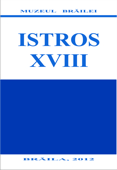Animal resources exploited at the beginning of the second millennium in the area between the Danube and the Black Sea: archaeozoological data
Animal resources exploited at the beginning of the second millennium in the area between the Danube and the Black Sea: archaeozoological data
Author(s): Simina Stanc, Luminiţa BejenaruSubject(s): Anthropology
Published by: EDITURA ISTROS A MUZEULUI BRĂILEI „CAROL I”
Keywords: Archaeozoology; quantification; fishing,hunting; animal husbandry
Summary/Abstract: The paper presents a zooarchaeological synthesis for settlements from the beginning of the second millennium in Dobrudja area:Dumbrăveni, Oltina (Altinum), Capidava, Isaccea (Noviodunum), Hârşova (Carsium), Piatra Frecăţei (Beroe), Nufăru (Prislava), for which archaeozoologicalanalyses had been made. The fauna remains from these samples are mollusc, fish, reptiles, birds and mammals; the greatest number is represented by mammal remains. The presence of fish, bird (wild and domestic) and mammal(wild and domestic) remains is an indicator of activities such as fishing, hunting and animal husbandry made by the people in these settlements. The most important activity is that of animal husbandry in six of the settlements. Among domestic animals, for six settlements the higher frequency (as number of remains) is represented by cattle (Bostaurus) and for the settlement of Dumbrăveni the highest preponderance is of sheep/goat (Ovisaries/Capra hircus), followed by cattle. Among wild mammals, the red deer (Cervuselaphus), the wild boar (Sus scrofaferus) and the roe deer (Capreoluscapreolus) appear in all samples, the first two having the largest share. The aurochs (Bosprimigenius) and the beaver (Castor fiber), lived in Dobrudja area at the beginning of the second millennium. The red deer had reduced a lot in time its areal range because of the forest clearance and is to be found today only in the Carpathian area. Among wild bird species, the black vulture (Aegypiusmonachus) had disappeared from our country's fauna and others – the white-tailed eagle (Haliaeetusalbicilla), the swan (Cygnus cygnusand Cygnus olor), the white pelican (Pelecanusonocrotalus), the cormorant (Phalacrocoraxcarbo), the lesser spotted eagle (Aquila pomarina) are currently species strictly protected by the law. There have been identified 12 species of fish belonging to Acipenseridae, Esocidae, Cyprinidae, Siluridae, Percidae families; all species of Teleostei live in sweet waters, being fished in the Danube, the lakes and rivers in the neighbourhood area; the Cyprinidae fish are the most representative in number.
Journal: ISTROS
- Issue Year: 18/2012
- Issue No: 1
- Page Range: 535-545
- Page Count: 11
- Language: English
- Content File-PDF

